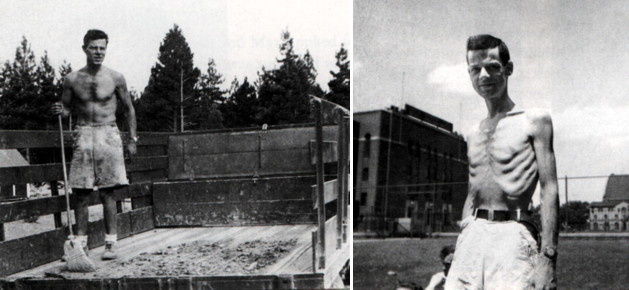Nor does a body utilize hundreds of thousands of kj instantly.
Even if you are exercising continually, such as someone hiking the length of Appalachian Trail who is, at the upper end, expending about 8000 kcal/day … that is still only about 33500 kj/day, and not hundreds of thousands of kj instantly.
Obviously, there is an upper limit at how fast someone can utilize stored fat for energy.
The question is are the numbers calculated by Dr. Alpert for people suffering from a calorie restricted standard diet suffering from a significantly depressed metabolic rate at all germane to a person in ketoes who is fasting, and eating no carbs at all? I think the answer is most likely no.
If I ate a chronically hypocaloric diet at the rate of 1570 kcal/day such as the subjects of the Minnesota starvation study, which contained a lot of starch, I think it very unlikely that I would be in a state of nutritional ketosis. Instead, I have been eating only about 57% of that caloric intake for months and have experienced none of the deprivations of starvation as reported by observing participants in that study.
At this very moment, this day, I am on the last day of a five day fast where my exogenous caloric input has been 0 kcal/day. I will leave it to the community of the forum to judge if I am suffering from the diminished mental acuity commonly observed in starvation study participants.
Does my personal anecdotal experience demonstrate that study participants where not in ketosis? Clearly not, but it certainly does give rise to a rational skepticism about whether or not Dr. Alper’s calculations have any relevance to people on a ketogenic diet who are fasting, or even to anyone who is not on the same diet as those participating in the Minnesota study.
I would no more recommend that people consume a very specific number of grams of fat while fasting based on Dr. Alper’s calculations than I would recommend that the American people eat a low fat, low cholesterol, high carbohydrate diet based on the diet-heart hypothesis.
I would be most pleased if someone would engage in a scientific study to answer the question of how rapidly fat deposits can be mobilized to be used as energy when a person is in ketosis. I don’t think anyone can answer that question by analyzing the data from the Minnasota starvation studies as I think it quite unlikely that participants in those studies where in ketosis.
Most Respectfully,
Richard





